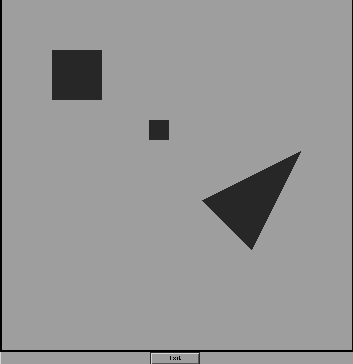
MOTIVATION
We have been working on a task involving the positioning of objects in space on the basis of spatial prepositions specified by the user. In this task, we generate an ellipsoid/paraboloid potential field for each individual spatial preposition; to represent combined prepositions, we superpose the fields. The LO(the object to be positioned) is placed at the point corresponding to the minimum obtained on combining the relevant fields. While generating these fields, a SWEET SPOT is chosen which determines the most likely position for placing the LO. Though the position of this SWEET SPOT is calculated keeping in mind the sizes of the ROs and LO and the available space, there is a certain measure of randomness involved in the calculation. Since our aim is essentially to model human linguistic behaviour visually, we would like to base our calculations on a psycholinguistic basis that provides us with a more correct picture of the way humans think, thereby enabling us to model human language more closely. Our aim, through this project, is thus to be able to determine the position of the SWEET SPOT in a more humanly-representative way.
Apart from these thoroughly practical motives, we were also motivated by the sense of adventure involved with venturing into a field we've never entered before. So far, we've done work which involved working only with machines. This project will give us the chance to interact actively with human subjects so as to get a better picture of how the human mind functions. Though the field of our study will necessarily be limited - we will be studying only linguistic traits connected to spatial reasoning - it will be our first step towards studying human cognition with the intent of translating it into practical and usable work.
Not only will we be delving into a branch of science we haven't worked much in, psychology, and learning more about psychometry and the science/art of administering tests, we will, in our view, be contributing to an area where much is still unexplored. A review of the connected literature shows clearly that there is an imperfect understanding of how people handle uncertainty in describing and analysing visual scenes. The hope that we will, through our work, be able to formalize to some extent the understanding of this important cognitive act is one of our strongest motivators.
The aforementioned, then, were our primary motives for taking up this project. We were enthused by the idea of formalizing an area of knowledge about which not very much is known. We were, to an extent successful in meeting this self-set goal. For example, when an object(LO) is to be placed between two other objects(ROs), then most human subjects place it such that the center of the LO coincides with the centre of the available space between the 2 ROs. This, we feel is a simple, yet important discovery. Till now,it was believed that the positioning of the LO did indeed depend on the distance between the centres of the ROs, but the exact relation was not, we believe, known.
From the results of our test, we have proved the observation stated above. We have also incorporated this capability into our spatial reasoning program.
An example will further illustrate this point:

A sample placement made by a human subject

A placement made by our program